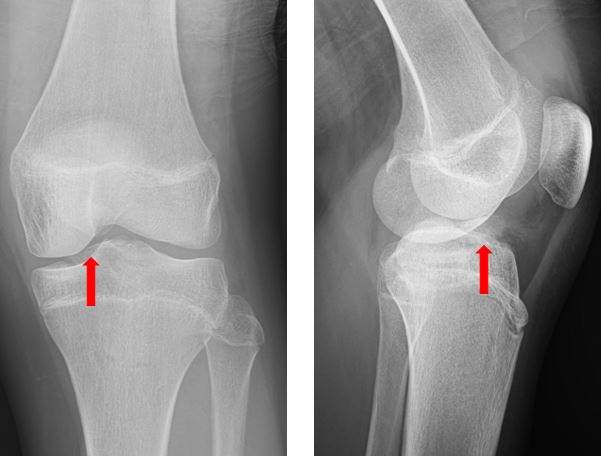Published on
Differential Diagnosis
- Tibial eminence (spine) fracture
- Collateral ligament injury
- Tibial tubercle avulsion
- Meniscal tear
- Patellar sleeve fracture
- Tibial plateau fracture

Diagnosis
This patient experienced a tibial eminence (spine) fracture.
Learnings/What to Look for
- Tibial eminence (spine) fractures are unique to the growing skeleton and affect only three in 100,000 children who sustain injuries to the knee annually1
- This fracture is a variant and similar to an ACL injury, also caused by hyperextension of the knee with rotation of the femur on the tibia
- X-rays should be sufficient to visualize fractures through the tibial eminence
- MRI or CT may be useful in further categorizing injury. In addition, MRI can help in identifying pieces of chondral fracture of the tibial spines
Pearls for Urgent Care Management
- Large effusions with significant pain or limitation of flexion benefit from arthrocentesis of hemarthrosis for symptomatic relief
- Initial treatment should include knee immobilization with fiberglass splinting in full extension and non-weight bearing with crutches
- Follow-up with orthopedics is recommended in 2-3 days for casting and to assess if surgical therapy is necessary. Significantly displaced avulsions require closed or open reduction with internal fixation
- Emergency department referral is necessary for any concerns about neurovascular status or for pain out-of-proportion
Reference
- Shin YW, Uppstrom TJ, Haskel JD, Green DW. The tibial eminence fracture in skeletally immature patients. Curr Opin Pediatr. 2015;27(1):50-57.
Acknowledgment: Images and case presented by Experity Teleradiology (www.experityhealth.com/teleradiology).
A 13-Year-Old Boy with Knee Pain After a Fall
1 2
